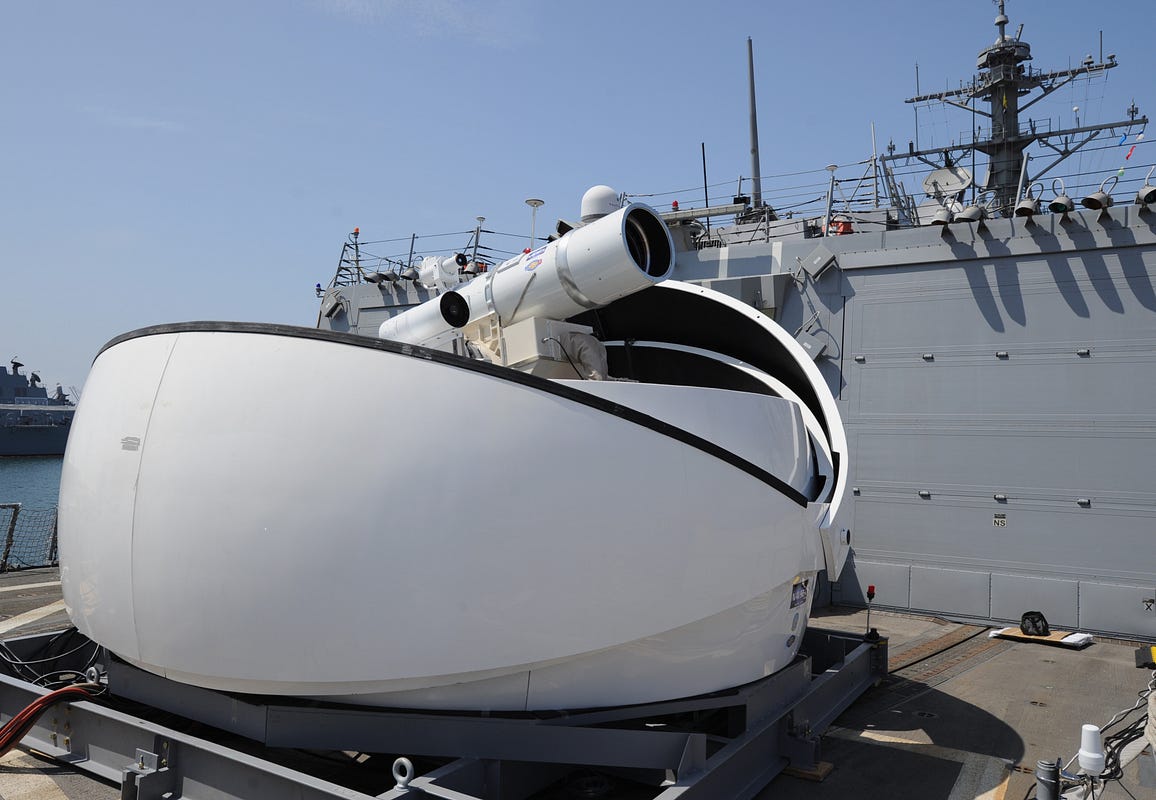Physics of directed energy favor surface troops
Jonathan Jeckell in War is Boring
America’s near-monopoly on precision-guided munitions and long-range surveillance technology is fast coming to an end. Large, immobile airbases, logistics stockpiles and even ships at sea soon will have no place to hide from far-reaching precision attacks.
One key technology could restore America’s advantage. The U.S. and Israel have had increasing success lately testing lasers to intercept missiles and artillery. We could be entering a new laser age—with huge implications for American military power.
But it could be a mostly defensive, ground-based laser age, to begin with. Aerial energy weapons need a lot more work and could lag far behind.
In December, the Army shot down 90 mortar rounds and several drones using a truck-mounted laser. The Navy is adding an experimental laser gun to its Persian Gulf base ship Ponce. The Army and Navy weapons work today. The Air Force, by contrast, is planning to install an energy weapon on jet fighters around the year 2030.
Now, the U.S. has had operational missile defenses since at least Operation Desert Storm in 1991, when it used Patriot missiles to intercept Iraqi Scud rockets with some success. But using missiles to intercept incoming ordnance is costly—and they can be overwhelmed by barrages of cheap, dumb projectiles or decoys.
Moreover, even if a theoretical missile defense system is 80-percent effective, two out of 1o rockets will still break through.The Navy’s laser gun, to be fitted to the base ship ‘Ponce.’ Navy photo
Laser defenses are not cheap, but are potentially far more economical and effective than launching physical projectiles to collide with or explode near falling warheads. Unlike missile defenses using projectiles—which must fight against gravity and require storage space and sophisticated manufacturing—lasers require only the requisite energy and the ability to shed excess heat.
Lasers also move at the speed of light, meaning the target would have no warning or opportunity to maneuver before it strikes. Suddenly the energetics that have favored air power are reversed.
Historically the high ground lent decisive advantages in combat because gravity works in your favor. Anti-aircraft shells and missiles flying up to intercept aircraft must struggle against gravity to approach their target. They lose energy, and the ability to maneuver, as they ascend.
Meanwhile, air-launched ordnance uses gravity to its advantage, increasing its range so it can often strike first and from a standoff distance. This has been a major factor in helping aircraft fend off increasingly sophisticated air-defense systems.
Lasers will level that field, as surface forces will have effective lasers first. Placing energy weapons on planes runs up against serious constraints on the weight and space needed for shedding waste heat and providing energy to the laser. The Air Force Airborne Laser project, for example, used up nearly all the interior space in a 747 for a laser capable of shooting down just a handful of ballistic missiles.
Better lasers might eventually solve these aerial problems with more compact cooling and improved energy generation—but these advancements will also enhance ground-based systems that don’t suffer gravity’s constraints. With energy weapons, the conditions are set for air defense to leap ahead of air attack.
Aircraft could become vulnerable to shots that come without warning, limited only by atmospheric dissipation of laser power and the curvature of the Earth. Meanwhile, ground-based systems can employ a far wider range of countermeasures—armor, camouflage, etc.—to protect themselves against air attacks long enough to get the first shot against attacking aircraft.
Combined with widely distributed multispectral sensors made possible by cheap electronics, air power as we know it suddenly faces a profound new challenge. A weapon anticipated by decades of science fiction as an offensive weapon could actually find its most compelling role in the defense, potentially restoring the U.S. forces’ advantage as rival countries get precision air power of their own.
Jonathan Jeckell is an Army officer who studies technology and strategy. This article represents his own opinion and does not necessarily reflect the positions of the Army, the Department of Defense or any U.S. government agency.

No comments:
Post a Comment